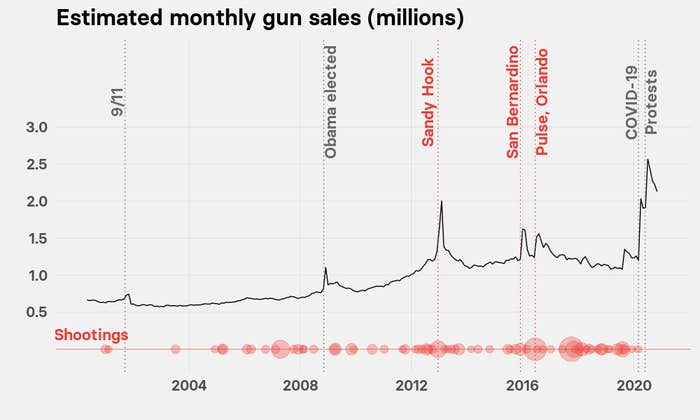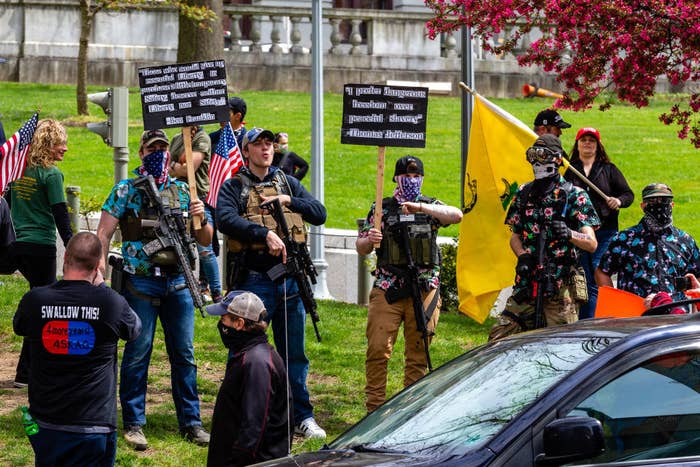
The US shattered all records for gun sales in 2020, spiking in the early months of the pandemic and during the summer’s racial justice protests, and continuing at historically high levels right up to an election mired by fears of growing unrest.
The chart above shows estimates of monthly gun sales, derived from background check data on prospective gun buyers compiled by the FBI, superimposed over mass shootings and other key events. The latest release of federal data, complete to the end of October, shows a monthslong trend of unprecedented sales.
BuzzFeed News has journalists around the US bringing you trustworthy stories on the 2020 elections. To help keep this news free, become a member.
This sustained surge massively exceeds the short-lived spike that followed the Sandy Hook school shooting in 2012. That and other peaks that occurred during the presidency of Barack Obama, as well as immediately following his election in November 2008, were likely driven by fears among gun owners about the possible imposition of new federal gun controls — especially in the wake of mass shootings. Shootings in which more than four people died are shown as red circles on the chart, scaled by the number of people killed.
In contrast, the 2020 sales surge seems to be a response to widespread anxiety about civil unrest as the nation has struggled with a pandemic, protests against police violence, and growing concerns about the potential for serious political violence around the election. A much smaller blip in sales happened after the 9/11 terrorist attacks, another time of intense national foreboding.
“There is a general underlying sense of fear and anxiety around this uncertain future,” said Nicole Kravitz-Wirtz, a sociologist and epidemiologist in the Violence Prevention Research Program at the University of California, Davis.

BuzzFeed News estimated gun sales from the FBI’s background check data using a method developed by Jurgen Brauer of the consultancy Small Arms Analytics & Forecasting. Gun sales are seasonal, usually peaking in December, so to reveal transient spikes we removed seasonal trends using a correction method developed by the US Census Bureau.
This revealed two clear peaks in sales within the wider surge this year: one immediately after pandemic lockdowns began in March, and a larger peak in June after the start of the Black Lives Matter protests.
In the uncorrected sales estimates, the peak in March was slightly higher than the spike in June. But since gun sales are normally much larger in March, our seasonally corrected chart highlights the June sales as the bigger aberration.
Brauer estimated that total 2020 gun sales, currently standing around 18.6 million, could reach 22 million by the end of the year — a huge increase on his estimate of 13.9 million for 2019.
The Obama-era sales spikes are thought to have been driven mostly by established gun enthusiasts. But new research from Kravitz-Wirtz and her colleagues indicates that many of the people rushing to buy guns in 2020 are first-time buyers. Extrapolating from a survey of 2,870 Californian adults conducted in July, the UC Davis team estimated that 110,000 people in the state had acquired a firearm in response to the pandemic, including 47,000 who had not previously owned a gun.
The researchers also found that more people are reporting keeping at least one gun loaded and not locked away in a gun cabinet. Extrapolating from their survey, they estimated that of some 823,000 current gun owners in California who stored at least one gun in this way, about 55,000 were doing so directly in response to their concerns about safety during the pandemic.
That’s a worry, given extensive evidence showing that the presence of a gun in the home greatly increases the risk of death and injury in households, Kravitz-Wirtz said, “especially in the context of people spending more time at home and the additional social and emotional stresses of the pandemic.”
Even before the pandemic, there were about two gun suicides to every gun homicide. But data on suicide comes with a significant lag, which means it’s too early to know for sure whether suicides are spiking.
Gun homicides have risen dramatically this year, however. According to a study from the National Commission on COVID-19 and Criminal Justice, homicides across 27 US cities were 53% higher between June and August 2020 than in the same period in 2019.
But given that there are thought to be at least 350 million guns in circulation in the US, it’s unclear whether much of this rise in gun violence can be attributed to new gun sales.
“I think that there’s a lot of things going on that are leading to suffering and stress and breakdowns in policing,” Daniel Webster, director of the Center for Gun Policy and Research at Johns Hopkins University, told BuzzFeed News. “All those things matter, independent of whether there’s more guns available.”
